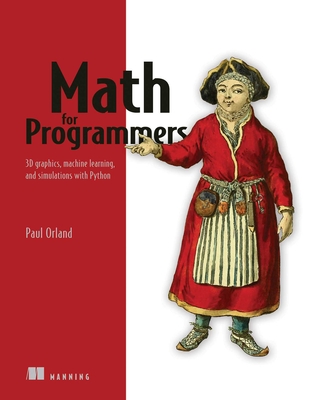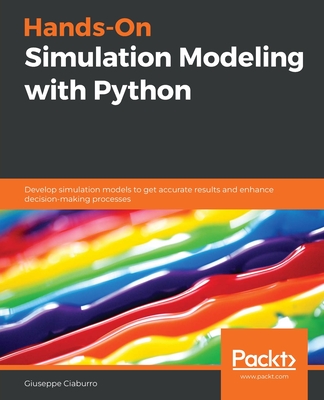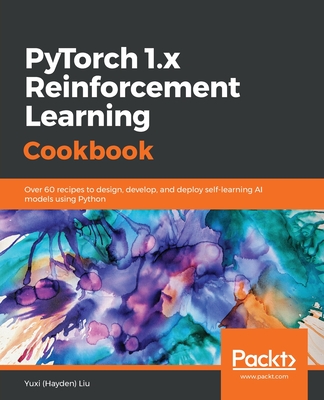Hands-On Simulation Modeling with Python: Develop simulation models to get accurate results and enhance decision-making processes
暫譯: 使用 Python 進行實作模擬建模:開發模擬模型以獲得準確結果並增強決策過程
Giuseppe Ciaburro
- 出版商: Packt Publishing
- 出版日期: 2020-07-17
- 售價: $2,270
- 貴賓價: 9.5 折 $2,157
- 語言: 英文
- 頁數: 348
- 裝訂: Quality Paper - also called trade paper
- ISBN: 1838985093
- ISBN-13: 9781838985097
-
相關分類:
Python、程式語言
-
其他版本:
Hands-On Simulation Modeling with Python - Second Edition: Develop simulation models for improved efficiency and precision in the decision-making proc
買這商品的人也買了...
-
 Introduction to Computation and Programming Using Python: With Application to Understanding Data, 2/e (Paperback)
Introduction to Computation and Programming Using Python: With Application to Understanding Data, 2/e (Paperback)$1,120$1,098 -
 $990Hands-On Machine Learning with Scikit-Learn and TensorFlow (Paperback)
$990Hands-On Machine Learning with Scikit-Learn and TensorFlow (Paperback) -
 Data Mining for Business Analytics: Concepts, Techniques, and Applications in R (Hardcover)
Data Mining for Business Analytics: Concepts, Techniques, and Applications in R (Hardcover)$4,600$4,370 -
 $1,188Deep Reinforcement Learning Hands-On
$1,188Deep Reinforcement Learning Hands-On -
 Hands-On GPU-Accelerated Computer Vision with OpenCV and CUDA: Effective techniques for processing complex image data in real time using GPUs (Paperback)
Hands-On GPU-Accelerated Computer Vision with OpenCV and CUDA: Effective techniques for processing complex image data in real time using GPUs (Paperback)$2,030$1,929 -
 Hands-On GPU Programming with Python and CUDA: Boost your application's performance and productivity with CUDA: Explore high-performance parallel computing with CUDA (Paperback)
Hands-On GPU Programming with Python and CUDA: Boost your application's performance and productivity with CUDA: Explore high-performance parallel computing with CUDA (Paperback)$1,740$1,653 -
 $1,805Foundations of Deep Reinforcement Learning: Theory and Practice in Python (Paperback)
$1,805Foundations of Deep Reinforcement Learning: Theory and Practice in Python (Paperback) -
 圖形演算法|Apache Spark 與 Neo4j 實務範例 (Graph Algorithms)
圖形演算法|Apache Spark 與 Neo4j 實務範例 (Graph Algorithms)$580$458 -
 ROS Robotics Projects, 2/e (Paperback)
ROS Robotics Projects, 2/e (Paperback)$1,880$1,786 -
 $1,824Math for Programmers: 3D graphics, machine learning, and simulations with Python (Paperback)
$1,824Math for Programmers: 3D graphics, machine learning, and simulations with Python (Paperback) -
 $2,340Linear Algebra and Optimization for Machine Learning: A Textbook (Hardcover)
$2,340Linear Algebra and Optimization for Machine Learning: A Textbook (Hardcover) -
 $1,480Interpretable Machine Learning with Python: Learn to build interpretable high-performance models with hands-on real-world examples (Paperback)
$1,480Interpretable Machine Learning with Python: Learn to build interpretable high-performance models with hands-on real-world examples (Paperback) -
 $2,080Data Mesh: Delivering Data-Driven Value at Scale (Paperback)
$2,080Data Mesh: Delivering Data-Driven Value at Scale (Paperback) -
 Data-Driven Science and Engineering: Machine Learning, Dynamical Systems, and Control, 2/e (Hardcover)
Data-Driven Science and Engineering: Machine Learning, Dynamical Systems, and Control, 2/e (Hardcover)$1,560$1,529 -
 Graph Data Science with Neo4j: Learn how to use Neo4j 5 with Graph Data Science library 2.0 and its Python driver for your project (Paperback)
Graph Data Science with Neo4j: Learn how to use Neo4j 5 with Graph Data Science library 2.0 and its Python driver for your project (Paperback)$1,730$1,644
相關主題
商品描述
Key Features
- Learn to create a digital prototype of a real model using hands-on examples
- Evaluate the performance and output of your prototype using simulation modeling techniques
- Understand various statistical and physical simulations to improve systems using Python
Book Description
Simulation modeling helps you to create digital prototypes of physical models to analyze how they work and predict their performance in the real world. With this comprehensive guide, you'll understand various computational statistical simulations using Python.
Starting with the fundamentals of simulation modeling, you'll understand concepts such as randomness and explore data generating processes, resampling methods, and bootstrapping techniques. You'll then cover key algorithms such as Monte Carlo simulations and Markov decision processes, which are used to develop numerical simulation models, and discover how they can be used to solve real-world problems. As you advance, you'll develop simulation models to help you get accurate results and enhance decision-making processes. Using optimization techniques, you'll learn to modify the performance of a model to improve results and make optimal use of resources. The book will guide you in creating a digital prototype using practical use cases for financial engineering, prototyping project management to improve planning, and simulating physical phenomena using neural networks.
By the end of this book, you'll have learned how to construct and deploy simulation models of your own to overcome real-world challenges.
What you will learn
- Gain an overview of the different types of simulation models
- Get to grips with the concepts of randomness and data generation process
- Understand how to work with discrete and continuous distributions
- Work with Monte Carlo simulations to calculate a definite integral
- Find out how to simulate random walks using Markov chains
- Obtain robust estimates of confidence intervals and standard errors of population parameters
- Discover how to use optimization methods in real-life applications
- Run efficient simulations to analyze real-world systems
Who this book is for
Hands-On Simulation Modeling with Python is for simulation developers and engineers, model designers, and anyone already familiar with the basic computational methods that are used to study the behavior of systems. This book will help you explore advanced simulation techniques such as Monte Carlo methods, statistical simulations, and much more using Python. Working knowledge of Python programming language is required.
商品描述(中文翻譯)
**主要特點**
- 學習使用實作範例創建真實模型的數位原型
- 使用模擬建模技術評估原型的性能和輸出
- 理解各種統計和物理模擬,以使用 Python 改進系統
**書籍描述**
模擬建模幫助您創建物理模型的數位原型,以分析它們的運作方式並預測其在現實世界中的性能。通過這本全面的指南,您將理解使用 Python 的各種計算統計模擬。
從模擬建模的基本原理開始,您將理解隨機性等概念,並探索數據生成過程、重抽樣方法和自助法技術。接著,您將涵蓋關鍵算法,如蒙地卡羅模擬(Monte Carlo simulations)和馬可夫決策過程(Markov decision processes),這些算法用於開發數值模擬模型,並發現它們如何用於解決現實世界的問題。隨著進步,您將開發模擬模型,以幫助您獲得準確的結果並增強決策過程。通過優化技術,您將學習如何修改模型的性能以改善結果並最佳化資源的使用。本書將指導您使用金融工程的實用案例創建數位原型,改進專案管理的規劃,以及使用神經網絡模擬物理現象。
在本書結束時,您將學會如何構建和部署自己的模擬模型,以克服現實世界的挑戰。
**您將學到什麼**
- 獲得不同類型模擬模型的概述
- 理解隨機性和數據生成過程的概念
- 理解如何處理離散和連續分佈
- 使用蒙地卡羅模擬計算確定積分
- 瞭解如何使用馬可夫鏈模擬隨機漫步
- 獲得對母體參數的置信區間和標準誤的穩健估計
- 發現如何在現實應用中使用優化方法
- 執行高效模擬以分析現實世界系統
**本書適合誰**
《Hands-On Simulation Modeling with Python》適合模擬開發者和工程師、模型設計師,以及任何已經熟悉用於研究系統行為的基本計算方法的人。本書將幫助您探索使用 Python 的高級模擬技術,如蒙地卡羅方法、統計模擬等。需要具備 Python 程式語言的工作知識。
作者簡介
Giuseppe Ciaburro holds a PhD in environmental technical physics, along with two master's degrees. His research was focused on machine learning applications in the study of urban sound environments. He works at the Built Environment Control Laboratory at the Università degli Studi della Campania Luigi Vanvitelli, Italy. He has over 18 years' professional experience in programming (Python, R, and MATLAB), first in the field of combustion, and then in acoustics and noise control. He has several publications to his credit.
作者簡介(中文翻譯)
Giuseppe Ciaburro 擁有環境技術物理學的博士學位,以及兩個碩士學位。他的研究專注於機器學習在城市聲音環境研究中的應用。他在意大利坎帕尼亞大學路易吉·范維泰利的建築環境控制實驗室工作。他在程式設計(Python、R 和 MATLAB)方面擁有超過 18 年的專業經驗,最初專注於燃燒領域,然後轉向聲學和噪音控制。他有多篇出版物。
目錄大綱
- Introducing Simulation Models
- Understanding Randomness and Random Numbers
- Probability and Data Generating Processes
- Exploring Monte Carlo Simulations
- Simulation-Based Markov Decision Process
- Resampling Methods
- Using Simulations to Improve and Optimize Systems
- Using Simulation Models for Financial Engineering
- Simulating Physical Phenomena Using Neural Networks
- Modeling and Simulation for Project Management
- What's Next?
目錄大綱(中文翻譯)
- Introducing Simulation Models
- Understanding Randomness and Random Numbers
- Probability and Data Generating Processes
- Exploring Monte Carlo Simulations
- Simulation-Based Markov Decision Process
- Resampling Methods
- Using Simulations to Improve and Optimize Systems
- Using Simulation Models for Financial Engineering
- Simulating Physical Phenomena Using Neural Networks
- Modeling and Simulation for Project Management
- What's Next?












